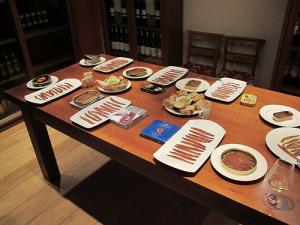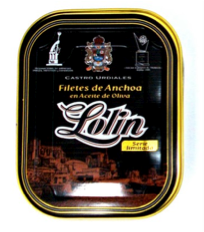 Some people find anchovies a bit fishy. I’ve seen small children and some not so small adults, throw tantrums, pull faces and flick the anchovies off their pizzas in disgust. These titchy relations of the herring are something of an acquired taste.
Some people find anchovies a bit fishy. I’ve seen small children and some not so small adults, throw tantrums, pull faces and flick the anchovies off their pizzas in disgust. These titchy relations of the herring are something of an acquired taste.
I love them, so when Jose Pizarro, ex of Brindisa and master of Spanish cooking, held a comparative tasting at top tapas restaurant Iberica I was there faster than you can say tinned fish fillets.
The Spanish revere the anchovy and preserve them by the time honoured and rather slow method of women hand gutting and topping and tailing the fish. These are then placed in barrels layered with salt to cure for up to three months. After that they are filleted and packed in tins with oil.
 Catalonia and Cantabria on the ‘Costa de l’Anxova’ or the Anchovy coast, are the centres of the industry and recently fishermen have had their quota allowance increased back to near previous levels so reinvigorating the local economy. The fact is that the anchovy has been over-fished, so look for labels that suggest responsible fishing.
Catalonia and Cantabria on the ‘Costa de l’Anxova’ or the Anchovy coast, are the centres of the industry and recently fishermen have had their quota allowance increased back to near previous levels so reinvigorating the local economy. The fact is that the anchovy has been over-fished, so look for labels that suggest responsible fishing.
The oldest method is using a lamparo – a light hanging from the prow of a boat floating inside a purse seine net. The fish mistake the lamp for the moon and come up to the surface. Traditional but insufficient to meet demand, hence the over fishing problem that led, at one sad point, to the Catalonian tinners having to buy their anchovies from France.
 The best tinned anchovies are meaty and salty and can be eaten straight from the tin. Trying over six varieties, along with a well-known supermarket’s version for comparison, it soon became apparent that like that other great Spanish treat, Iberica Ham, there is a great deal of difference in taste and texture.
The best tinned anchovies are meaty and salty and can be eaten straight from the tin. Trying over six varieties, along with a well-known supermarket’s version for comparison, it soon became apparent that like that other great Spanish treat, Iberica Ham, there is a great deal of difference in taste and texture.
Some had a salty blast that persisted rather annoyingly, others delivered a smooth hit of salt that morphed into flavour. Anchovies are in fact pure umami, which is why they are used in Worcestershire Sauce and also in Thai cooking.
The tins the best anchovies come in are as attractive as the fish inside, miniature works of art often with designs that have remained unchanged for decades. It all speaks of quality and so does the price. 47 gram tins can cost from around £4.00 to up to and over £7.00, compared to standard anchovy tins in the supermarket at around £1 30.
You get what you pay for though, the cheaper grey and mushy ones are okay for making a broccoli, pasta and chilli dish, but are not okay for eating from the tin. Sat on their plate they looked thin, undernourished and tasted over salted.
When it came down to deciding on the best, Jose wouldn’t be drawn until we had all made our choice. Gratifyingly we all agreed with him that two brands stood out, including my favourite Don Bacarte from Cantabria with fish caught in the Bay of Biscay and processed traditionally.
Most of the brands we tried are hard, if not impossible, to buy in the shops, but it’s worth checking the Internet, especially if you speak a bit of Spanish. You may be able to buy direct from Spain.
The little fish has a lot going for it, so spend the extra and get much more.
Find out more about Jose at www.josepizarro.com
 Conservas Hoya
Conservas Hoya
C/ Cabildo, s/n, 39740 SANTOÑA – CANTABRIA – SPAIN
Tel: +34 942 66 01 62 begin_of_the_skype_highlighting
E-mail: [email protected]
Conservas Codesa S.L
Pol.Ind La Pesquera – 39770 LAREDO – CANTABRIA – SPAIN
E-mail: [email protected]
Conservas Emilia
Avenida de Lons, 39740 SANTOÑA – CANTABRIA – SPAIN
Tel: +34 942 663 232
E-mail: [email protected] |
 Conservas Revuelta
Conservas Revuelta
La Mar, 47, 39750 COLINDRES – CANTABRIA – SPAIN
Tel: +34 942
E-mail: [email protected]
Conservas Lolin
Polígono Brazomar s/n – 39700 CASTRO URDIALES – CANTABRIA – SPAIN
E-mail: [email protected]
Tel: +34 942 86 445 40
Conservas Don Bocarte
c/ Baldomero Villegas s/n , 39740 SANTOÑA – CANTABRIA – SPAIN
Tel: +34 942 661 920
E-mail: [email protected]
